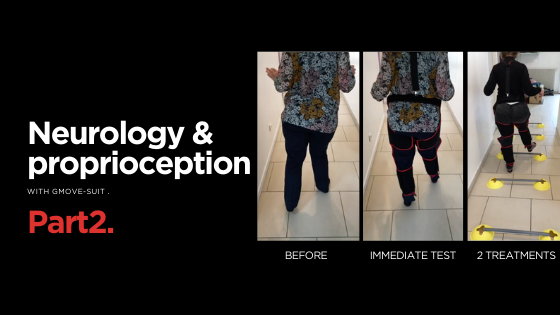OTHER TESTS
TEST ON MEMBERS OF THE BOARD OF THE NATIONAL EDS ASSOCIATION, WHO PARTICIPATED IN THE CALIBRATION PHASE FOR THE PURPOSE OF TESTING ON A LARGE NUMBER OF SUBJECTS(25 SUBJECTS):
This involved equipping 3 people with the GMOVE-SUIT and having them wear it at various intensities (from 50 mmHg to 100 mmHg) for 5 minute periods. During these periods, an EVA pain scale was used. As soon as 7 points was reached, the test was stopped. For EDS versions (hypermobile and vascular), 100 mmHg was reached and corresponded to their limit. For the hypermobile version, 110 mmHg was bearable.
Treadmill walking test (MS with lesions predominantly on the right)
Without the GMOVE-SUIT:
– Clear difference in stride length -Tendency toward internal rotation with tiptoes turning inward
– Feet tend to grip the floor
– Patient tends to zigzag when walking
With GMOVE-SUIT (program 2 – 40 mmHg):
-Better control overall of the gait with improvement in all of the points listed above
Test on patients with Parkinson’s – 4G Program at 80 mmHg
«There was the same feeling of lightness. The patient described “improved control.” The explanation seems to be proprioceptive with improved feeling in the lower limbs leading to better posture with improved dynamic balance. With the machine off, turning around is much more difficult and walking more hesitant».
Frédéric Delacour, physiotherapist in Paris
Test on a patient with multiple sclerosis with cerebellar syndrome – 4G Program at 80 mmHg
“We are still in the testing mode, but initial results with neurologic patients are rather impressive. Here, the patient feels lighter which makes walking easier as well as improving balance“.
For these 2 neuro patients, the practitioner conducted a “get up & go” test (measuring the time it takes to get out of a chair, walk 3 meters, turn around and sit back down). This is an approved predictive test of fall risk. The GMOVE-SUIT can significantly decrease the time.
Frédéric Delacour, physiotherapist in Paris
TESTIMONIES
“It was a big surprise about the pain in the legs, which almost disappeared during the test. The regained mobility is quite impressive, as well as I felt a big advantage in terms of balance and walking. I felt a real difference. Once the device was removed, the pain came back, with the feeling of weight in the legs, walking difficulties again, as well as knee and right calf pain. I find the test rather surprising and the effects very interesting”.
Delphine, SED patient
“It’s a pretty impressive experience. When I put the device on, I had a feeling of lightness that allowed me to walk better. I moved well. When you take the device off, you find your legs heavy, like concrete. It’s destabilizing to see these pains coming back.
Aurelie, vascular SED patient
“I felt a very great sense of well-being and above all a relaxation as the pressure increased, in all the muscle chains, from the foot to just above the pelvis. I found it easy to walk, the feeling is pleasant. The pain comes back sharply when you remove the GMOVE-SUIT, with this feeling of weight and a hardening of all the muscle chains again “.
Christelle, hypermobile SED patient
The improvement on the chronometric aspect can be explained by the contribution of GMOVE-SUIT at the qualitative level: patients do not need to help themselves by using their hands to get up and simply achieve this by using leg strength, which is an important criterion. The half turn is also improved, as is the length of the step. All these points put together lead to the measured time improvement.

